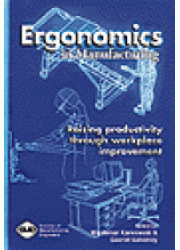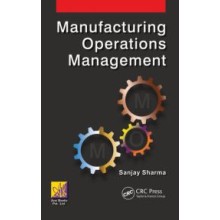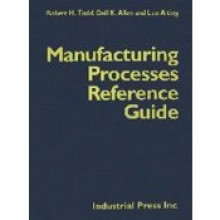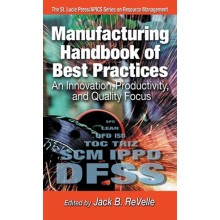Your shopping cart is empty!
Welcome visitor you can login or create an account
Ergonomics in Manufacturing Raising Productivity Through Workplace Improvement
Publisher: SME
ISBN: 9780872634855
Author: Gavriel Salvendy, Waldemar Karwowski
Dispatch Time: 2 - 3 Days
ISBN: 9780872634855
Author: Gavriel Salvendy, Waldemar Karwowski
Dispatch Time: 2 - 3 Days
Our Price: $115.00
Quantity:
-
Add to Compare
This handy resource brings you proven methods for ergonomic job design and evaluation that impact your company's bottom line. Editors Waldemar Karwowski and Gavrial Salvendy have assembled the foremost international experts from industry, government, and academia to contribute their views. Each is backed by an impressive number of enlightening case studies and real-world examples supported by figures and tables that are essential to any effective ergonomics plan.
"Ergonomics in Manufacturing" explains how to prevent cumulative trauma disorders and the number one reason for worker's comp claims - lower back injuries. Learn to organize and manage ergonomics efforts, and discover how to achieve profitable results using various corporations around the world as models for success.
Contents:
PREFACE
1.ERGONOMICS IN PLANT OPERATIONS.
"Ergonomics in Manufacturing" explains how to prevent cumulative trauma disorders and the number one reason for worker's comp claims - lower back injuries. Learn to organize and manage ergonomics efforts, and discover how to achieve profitable results using various corporations around the world as models for success.
Contents:
PREFACE
1.ERGONOMICS IN PLANT OPERATIONS.
2.PARTICIPATORY ERGONOMICS-A PRACTICAL GUIDE FOR THE PLANT MANAGER
What is Participatory Ergonomis?
The Benefits
Is Participatory Ergonomics Best?, Assess Readiness, Moving
Toward Participatory Ergonomics, Getting Started, Analysis Process
Keeping it Going
Monitoring Progress and Evaluating the Process, Methods
Opprtunities
3.LOWERING COSTS THROUGH ERGONOMICS
Case Studies
Forestry Industry, Material Handling Workstation
Redesign, Reducing Work-related Musculoskeletal
Human Factors Test and Evaluation
Macroergonomics
4.MANUFACTURING WORKSTATION DESIGN
Applying Engineering Anthropometry to Workstation Design
Applying Engineering Anthropometry to Workstation Design
Adjusting Anthropometric Data
Datermining Workstation Design Parameters
Determining Workstation Dimensions
Work Height, Normal and Maximum Reaches, Lateral Clearance,
Angle of Vision and Eye Heght
Case Studies
Supermarket Checkstand Workstation
Computerized Human Modeling Prgrams for Workstation
Design
CYBERMAN, COMBIMAN, CREW CHIEF, JACK, SAMMIE, MANNEQUIN
5.A DESIGN AND SELECTION GUIDE FOR HAND HELD TOOLS
Evolution of Tools
Evolution of Tools
Two Categories, Proper Matching, Anatomy of the Upper
Extremities
Injuries and Illnesses from Haand Held Tools
A Surver, Injury Prarameters
Principles of Hand Tool Design
Effects of Grip Type, Size, and Shape; Effects of Gloves; Effects of
Wrist Position; Effects of tool Weight and Muscle Group
Safety Considerations
6.COMPUTER-AIDED DESIGN FOR ERGONOMICS AND SAFETY
Gathering Safety Data
Gathering Safety Data
Standardization
Safety Management Information Systems
Supportive safety Information; Job Risk Assessement and
Participatory Safety and Health; Training and Instructional
Spftware Packages; Simulation Softwares for Ergonomics; Job
Design Tools for Ergonomics; Examples of Computer-aided
Safety, Health, and Ergonomics, Examples of Computer-aided
Safety, Health, and Ergonomics, Examples of Computer-aided
Design for Ergonomics;Interactive Ergonomic-oriented Production
System Design; TRANSOM JACK Human Madeling; IGRIP
Software
Integration of Safety and Ergonomics
7.ERGONOMICS TRAINING AND EDUCATION FOR WORKERS AND MANAGERS
Characteristics of Good Training
Characteristics of Good Training
Nature of the Adult Learner, Role of the Trainer/Facilitator, the
Environment
Five Phases
Planning, Development, Measuring the Inpact,
Integration and Improvement
Job-specific Training
Managers; Health and Safety Professionals; Manufacturing
Engineers; Supervisore, Technicians, Ergonomics team Leaders,
Lobor Representatives; Employees; Medical and Human Resource
Professionals
8.ASSESSING PHYSICAL WORK LOAD
Physical Load at Work
Physical Load at Work
Physiology of Muscular Work, Static Muscle Work, Effect of the
Size of Working Muscle Mass, Muscular Overload, Field Methods
for Assessing Physical Overload, Heavy Dynamic Muscle Work
Manual Material Handling, Static Muscle Work, Repetitive Work,
Physical Work Load Assessment in Practies
Preventing Physioloogical Overload
9.STATIC WORK LOAD AND ENDURANCE TIMES
Maintaining Working Postures
Perceived Discomfort, Maximum Holding Time Maximum Holding
Time versus Discomfort, Maximum Acceptable Level of Discomfort
Workstation Design and Adjustment
Sewing Machine Operation, Press Operation, Hand Positions
Standards
Scope, Contents
Work-rest Model
Software, Example
10.WORKER STRENGTH EVALUATION : ERGONOMIC AND LEGAL PERSPECTIVES
Musculoskeletal Disorders
Ergonomic Job Design
Methods of Strength Evaluation
Isometric Testing, Isokinetic Testing, Isoinertial Testing, Comparing
Strength Evaluation Methods, Selecting a Strength Evaluation
Method
Legal Implications
The Americans with Disabilities Act, Examples
11.METHODS FOR EVALUATING POSTURAL WORK LOAD
Work Posture
Health Effects of Awkward Posture, Productivity Effects of Awkward
Posture, Posture Analysis Methods, Exposure Assessment Methods,
Root Cause Analysis Methods
A Case Study
Pre-change Analysis, Ergonomic Changes, Post-change Analysis
12.MANUAL MATERIAL HANDLING : DESIGN DATA BASES
Models
Examples
Reducing Exposure to Manual Material Handling Hazards
13.ASSESSMENT OF MANUAL LIFTING – THE NIOSH APPROACH
The Body of Work
Recommended Weight Limit (RWL), Measurement Requirements,
Lifting Index (LI), Miscellaneous Terms, Equation Limitations,
Horizontal Component, Vertical Component, Distance Component,
Asymmetry Component, Frequency Component, Special Frequency
Adjustment Proccedure, Coupling Component
Procedures
Step 1: Collect Data, Step2: Single-and Multi-task Procedures
Applying the Equations
Using the RWL and LI, Job -related Intervention Strategy
Example Problems
14.PERSPECTIVE ON LIFTING BELTS FOR MATERIAL HANDLING
Prevention Attempts
Personnel Training, Personnel Selection, Job Design
External Support Devices
Back Support Belts, Weight-lifting Belts, Industrial Back Support
Belts, Unknown Factors
Rationale for Using Back Support Belts,
Effect of Back Support Belts, Epidemiological Research
Physical Tesearch
15.TRAINING AND EDUCATION IN BACK INJURY PREVENTION
Impact Points
Prior to the Hire, After After the Hire
Prevention Programs
Audit Assessment, Back Belts, Education, Ergonomics, Exercise
Fitness
Functional Capacity Assessements
FCA Principles, FCA Reporting and Outcomes, FCA
Standardization
Functional Therapy
Job Analysis
Job Placement Assessments
JPA Outcomes, "Tool Box Talkx"
16.AN OVERVIEW OF UPPER EXTREMITY DISORDERS
Five Disorders
Trigger Finger and Triger Thumb, de Quervain's Tenosynovitis,
Peritendinitis, Lateral Epicondylitis, Carpal Tunnel Syndrome
17.CUMULATIVE TRAUMA DISORDERS IN INDUSTRY
What are CTD s?
CTD Incidence and Costs, Common CTDs in Industry, CTD Risk
Factors
Surveillance Methods
Passive Surveillance, Active Suveillance
Prevention and Control of CTDs in Industry
18.ANSI – Z365 STANDARD : CONTROL AND PREVENTION OF CUMULATIVE TRAUMA DISORDERS
Developing ANSI-Z365
The ANSI Role
The Process
The Accredited Standards Committee, Compliance
Structure and Contenl
Components
Issues and Concerns
Additional Factors
Other Standards
19.MANAGING WORK-RELATED MUSCULOSKELETAL INJURIES
Three-Tier System
Widespread Commitment
Management's Role
Human Resources' Role
Engineering's Role
The Supervisor's Role
The Operator's Role
Medical Management's role
The Safety Other Production Support Groups
Integration
20.ERGONOMICS : PART OF CONTINUOUS IMPROVEMENT
Terminology
Right and Wrong Terms
Effective Implementation of Ergonomics
Policy and Procedures Document, Employee Involvement,
Ergonomics Committee, Surveillance Methods, Job -site Analysis
Methods, Ergonomics Training
Medical Management Program
Prevention
21.VIBRATION-INDUCED CUMULATIVE TRAUMA DISORDERS
The Nature of Vibration
Whole body Vibration
Hand-arm Vibration
Vibration Measurements
Standards
Controlling Vibration in the Workplace
22.EVALUATING ERGONOMICS PROGRAMS
The Ergonomics Process and Its Evaluation
Management Commitiment, Employee Involvement
Control and Prevention of Occupational Health Hazards
Work Site Analysis, Hazard Prevention, Medical Management
Training The Bottom Line
Control of Conditions Affecting Performance
Evaluating Products of the Organization
Outreach within the Trade
Contributions to the Technical/Legislative Community
23.AUDITING ERGONOMICS
Measurement, Change, and Auditing
Why Audit Ergonomics?
Choices for an Audit System
Types of Checklists, Audit Design
How to Audit Ergonomics
An Ergonomics Audit Example
Lessons from Auditing
24.ECONOMIC EVALUATIONS OF ERGONOMIC INTERVENTIONS
Benefits and Costs
Interest Calculationds and Discounted Cash Flows
Inspection Economics
Inspection Costs, Rate Considerations in Inspection, Locoation of
the Inspection Stationg
Economics of Learning
Training and Transfer
Lifting Belts and Economics
25.WORLDWIDE CORPORATE ERGONOMICS EFFORTS-USA
The Growth of Ergonomics
The Profession
Polarization of Physical and Cognitive Ergonomics
Physical Ergonomics in Industry
Organizational Factors, Ergonomics Programs, Cumulative Trauma
Disorders
Commercial Opportunities
Training, Job Analysis, Physical Devices
The Problem of Science and Standards
Consensus, Ergonomics Standards
Exposure-The Time Factor
Teams
Objectives of Ergonomics
Fitting the Tasks, Preventing Unwanted Outcomes
Anthropology of Work
26.CORPORATE ERGONOMIC EFFORTS IN GERMANY
Evolution of Ergonomics
Motives of Ergonomics
Economic Efficiency, Humanization, Normative and Legal Aspects,
Sociodemographic Development
Institiutions Involved in Ergonomics
Public Institutions and Programs, Science and Requirements and Methods, Examples
Ergonomic Design
Gooals, Applications, Design Requirements and Research Institutions
of Ergonomic Design
27.CORPORATE ERGONOMIC EFFORTS IN SWEDEN
Strategies on the National Level
Internal Control, Impact of the Swedish Foundation of Work Life
Ergonomics as a Professional Field
Ergonomic Equipment for Industrial Production
Cases from the Manufacturing and Servies Industries
The Case of ABB. Automotive Cases-Volve and Saad,
Sociotechnical Job Design in Sawmills, Servics Industry-Tools for
Ergonomic Improvements
28.ERGONOMICS AND TQM
TQM Philosophy
Objectives of Ergonomics
Ergonomics as a Change Agent
Health Promotivon in TQM
Occupational Safety and Health as a Quality Target, Economicsand Health Promotion
Organizational Development througjh Health Promotion
Areas of Conflict, The Problem of Applyine TQM
Write a review
Your Name:Your Review: Note: HTML is not translated!
Rating: Bad Good
Enter the code in the box below:
Price subject to change without notice
Copyright © 2014 Engineering Standards Bureau. All Rights Reserved.
Developed By Zoom Into Web
Copyright © 2014 Engineering Standards Bureau. All Rights Reserved.
Developed By Zoom Into Web







